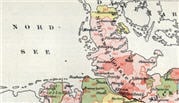Source Information

About Saarland, Germany, Deaths, 1876-1933
About this collection
This collection contains death records from the modern German state of Saarland covering the years 1876 up to and including 1933. Additional records will continue to be added to this collection. Refer to the box "Browse this collection" to see which communities (Registration Office) and year ranges have records available. Saarland has alternated constantly between German and French rule. The records reflect the eventful history of the region.
Beginning on January 1, 1876, birth, marriage and death records in the former German Empire were created by local registry offices. The collected records are arranged chronologically and usually bound together in the form of yearbooks. These are collectively referred to as "civil registers." Complementary alphabetical directories of names may also have been created. While churches continued to keep traditional records, the State also mandated that the personal or marital status of the entire population be recorded.
What you can find in the records
Death records were created using preprinted forms that were filled in by hand by the registrar. In each record, the date of death usually differs from the date it was registered. Depending on the individual form or on the formulations used by the registrar, you may find:
- Sequential or Certificate Number
- Informant: Given Names, Last Name, Maiden Name, Occupation, Residence/Address, Denomination
- Deceased: Occupation, Given Names, Last Name, Maiden Name, Age, Denomination, Residence/Address, Place/Date of Birth, Spouse/Parents, Place/Date of Death, Time of Death
- Signatures
More about using this collection
Each record comprises one page. Additional events from the life of the deceased were sometimes recorded later on in the margins. These notes, sometimes referred to as "narration," can contain very useful information but they have not been indexed. As a result, information from the notes will not found via the search form. The “Informant” was usually a relative of the deceased. In later years death information was often submitted by hospital administrators or by an undertaker.
Under "Browse this collection,” select the Civil Registration Office and Year Range of the register desired. There may temporarily be gaps in the records. For example, some registry books may be undergoing restoration at the archive and could not be digitalized.
 Need help with the German language? Find resources in our German Research Center.
Need help with the German language? Find resources in our German Research Center.